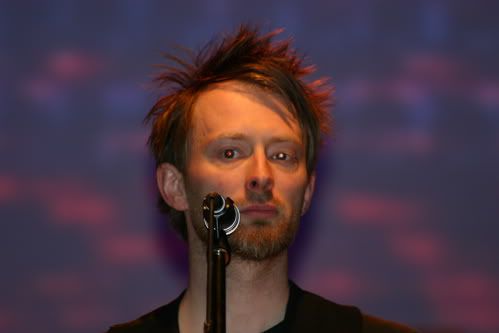Donwood Dresses Up Thom Yorke Solo Album
June 15, 2006, 2:20 PM ET
Katie Hasty, N.Y.
Artist Stanley Donwood was fascinated by the floods in Cornwall, England, two years ago, inspiring part of his recent exhibition, "London Views." His woodcuts and general interest in the catastrophes of London also seemed to jive with Thom Yorke's upcoming solo release, "The Eraser." And it's his piece "Cnut" that will ultimately grace the cover of the album, due July 11 via XL.
"As often happens, the concurrent work that we were doing -- Thom with the music, and me with the artwork -- seemed to intertwine," Donwood tells Billboard.com. "We realized that the 'London' stuff would fit perfectly with 'The Eraser,' which in a lot of ways seems a very English record. There was something about this immense torrent washing everything away and the futile figure holding back the wave (or failing to) that worked with the record, especially as we had both seen the flood, just when Thom was starting on the music that would eventually become 'The Eraser.'"
"The Eraser" is packaged as one large foldout card of art, in which the CD will be slipped. "The packaging was a bit of a f***er, because the picture at actual size is about 12 feet long," Donwood admits. "We both wanted to avoid using plastic, apart from the CD itself of course."
Donwood (whose real name is Dan Rickwood -- "I like to separate the person I am at home -- washing up, vacuuming, picking up the kids from school and so on -- from whoever Stanley Donwood is," he says) has been friends with Yorke since their days at the University of Exeter. The pair won the best album packaging Grammy for Radiohead's 2001 album, "Amnesiac."
"[The Grammys] didn't really work out well," Donwood says. "A lot of the things that happened on that visit to Los Angeles were utterly alien to me and quite frightening. I smoked too much evil Californian weed and got the heebie jeebies. I was too paranoid to go to the after party and I had an unpleasant run-in with some over-zealous post-Sept. 11 security guards."
Artwork from his various projects is available through Donwood's Web site, which also features some of his writings. But despite his Radiohead association, Donwood says he's never dabbled in music of his own.
"I can't read music, can't tell a guitar from a bass and haven't ever tried to play anything. It's a sort of blind spot in my life," he laments. "I mean, I suppose being a musician is vaguely equivalent to being an artist or a writer -- but much better. Music is more immediate than [visual] art or writing because it has a visceral reach and can alter your mood much more comprehensively and immediately."
As one would expect, Donwood has been given a sneak peak into some new Radiohead material, much like audience earlier this week at the band's New York shows.
"All [the songs] are good! There are a couple of songs -- 'Down Is the New Up' and 'Videotape' -- that are so beautiful. I just pray they don't f*ck them up in the studio. But as I said, I know nothing about music, so really I should keep my gob shut," he jokes. "I think the new work demonstrates a kind of freedom or release. The long-awaited happy album from Radiohead it is not, but I think there's an amount of dark humor in it. Or not."
